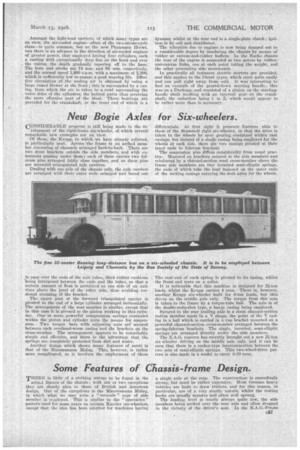New Bogie Axles for Six-wheelers.
Page 67

If you've noticed an error in this article please click here to report it so we can fix it.
CONSIDERABLE progress is still being made in the development of the rigid-frame six-wheeler, of which several
remarkable new examples are on view. •
Of these, the Krupp, to which we have already referred, is 'particularly neat. Across ;theframe is an arched 'member Consisting of channels arranged•back-to-back. There are. two stout brackets outside the side members, and With extensitins passing .Under them ; each of these carries two fulcrum pins arranged fairly close together, and an these pins are mennted triangulated axle carriers.
Dealing with one side of the ehassia only, the axle carriers are arranged with their outer ends enlarged a id bored • out• to pass over the ends of the axle tubes, thick rubber cushions being interposed between the ends and the tubes, so that ,a certain amount of float is permitted as one side of an axle rises above the level of the ether side, thus avoiding torsional stressing Of the bracket.
The upper part of the forward triangulated carrier is pivoted to the end of a large cylinder arranged horizontally. The •arrangement of the rear member is similar, except that in thiscase it is pivoted to the piston working in this cylinder. One or more powerful compression springs concealed within the piston and cylinder form the means for suspension. Two torque bars with adjusting nuts are secured between each overhead-worm casing and the brackets on the cross-member. The arrangement appears to be remarkably simple and effective, and there is the advantage that the springs are completely protected from dirt and water, Another design which shows many features of merit is that of the Mannesmann Mulag. This,however, is rather more complicated, as it involves the employment of three differentials. At first sight it preSents features akin to those of the Scammell rigid six-wheeler, in that the drive is taken to the wheels by spur gearing contained within 'cast casings, but instead Of a single casing being employed for the wheels at each side., there are two casings pivoted at their inner ends to fulcrum brackets.
The suspension also differs considerably from usual practice. Mounted on brackets secured to the side members: and reinforced by a channel-section steel cross-member above the frame side members are two inverted semi-elliptic springs, the ends of which take the load imposed on the outer ends of the rocking casings carrying the. stub axles for the wheels.
The rear end of each spring is pivoted to its easing, whilst the front end rests on a roller.
It is noticeable thatthis machine is designed for 2i-ton loads, whilst the Krupp earrie$ 4 tons. • There is, however, another Krupp six-wheeler built for 8-tan loads, but this drives on the middle axle only. The torque from this axle is taken to the frame by a torque-tube ball. The axle is of the double-reduction type, a banjo casing being employed. Secured to the rear trailing axle is a stout channel-section radius member made in a V shape, the point of the 17 ending in a ball which is carried in a cup bracket mounted on a powerful channel-section cross-member arranged between the spring-fulcrum brackets. The single, inverted, semi-elliptic sPring,s arc arranged directly under the side members.
The N.A.G. concern has recently brought out a new 2i-ton six-wheeler driving on the middle axle only, and it can be seen that there is a rocker-type interconnection between the two sets of semi-elliptic springs. This two-wheel-drive pattern is also made in a model to carry 8-10 tons.




























































































































